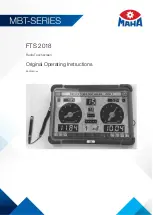
7-38
2000-OSM, F1
NOTE
If the Photomultiplier Tube has very high gain, the reading of step 5 might not be
adjustable to a value less than 80 mV.
TP 44: FPD FLAME WILL NOT LIGHT
CAUTION
Do not ignite the FPD flame if the temperature is below operational level. Low
detector temperature will result in condensation damage to the flame cell.
Flame Out LED is lit.
1. Verify the flame is ignited by observing condensation of water vapor at the detector vent.
2. If there is no condensation, the flame is not lit; go to step 4. If condensation is present, check the
detector offset (background).
a. Disconnect the red coaxial lead from the photomultiplier tube (PMT).
b. Connect a digital voltmeter (with 10 megohms input impedance) between ground and the
center pin of the PMT coax connector.
c. Record the meter reading. If it is less than 30 mV go to step 3.
d. If it is more than 30 mV, the detector is normal. Replace the Electrometer PCB or Chroma I/O
PCB.
3. Check the PMT supply voltage on the Electrometer.
a. At pin A of the 3-pin connector on the PMT housing, you should get at least 40V + 4.5V per
turn of the gain pot.
b. If the voltage is too low, check the Electrometer PCB supply voltages, ± 15volts.
c. If the Electrometer PCB supply voltages are correct, replace the Electrometer PCB.
d. If the Electrometer PCB supply voltages are low or missing, replace the Power Supply PCB.
4. If the flame is not lit, perform the following steps.
a. Ensure burner air and burner fuel are adjusted to the value shown on application data sheets.
b. If flows and pressures cannot be adjusted, perform
Test Procedure 31
(Plugged Jet or
Breather).
c. Jet is too high.
d. Jet is broken.
Flame Out LED is not lit.
1. Ensure burner air and burner fuel are adjusted to the value shown on application data sheets.
2. If flows and pressures cannot be adjusted, perform
Test Procedure 31
(Plugged Jet or Breather).
















































